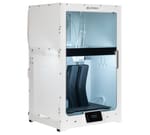There’s no doubt that Bambu Lab, with its ability to quickly and accurately print engineering-grade materials like nylon, has lit a fire under companies like UltiMaker, which have been making desktop FDMs since 2011. Certainly, the professional desktop FDM market — into which UltiMaker has moved — is under pressure from innovative companies in the consumer space.
But don’t write off UltiMaker just yet. In fact, take a closer look. From All3DP’s talks with the company about its flagship S8 ($9,000) launching today, UltiMaker engineers are innovating (not copying) and aiming to deliver on user demands for more speed, precision, flexibility, and efficiency.
How UltiMaker Got to the S8
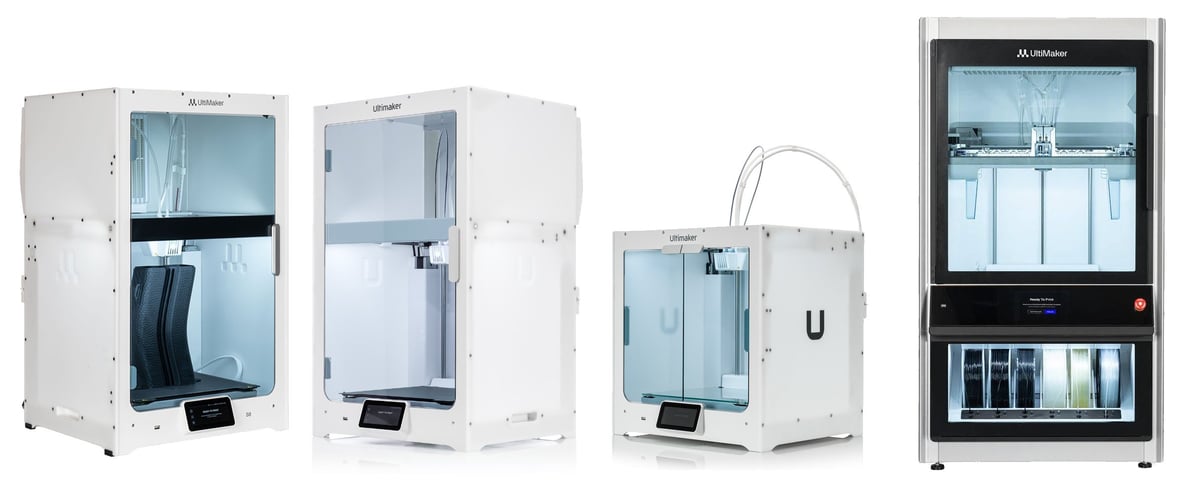
About two years ago, UltiMaker launched the S7, and, less than a year ago, the company took a new path in FDMs with the “light-industrial” Factor 4.
The S8 is not positioned as an upgrade or an improvement on either, according to UltiMaker, but a completely different chapter — even though from the outside it’s practically identical to the S7.
The S8 offers four-times the speed, five-times the processing power, and improved part quality, UltiMaker told us, but we wanted to dig deeper and talk to an engineer about exactly how.
A “New Chapter” for the S Series
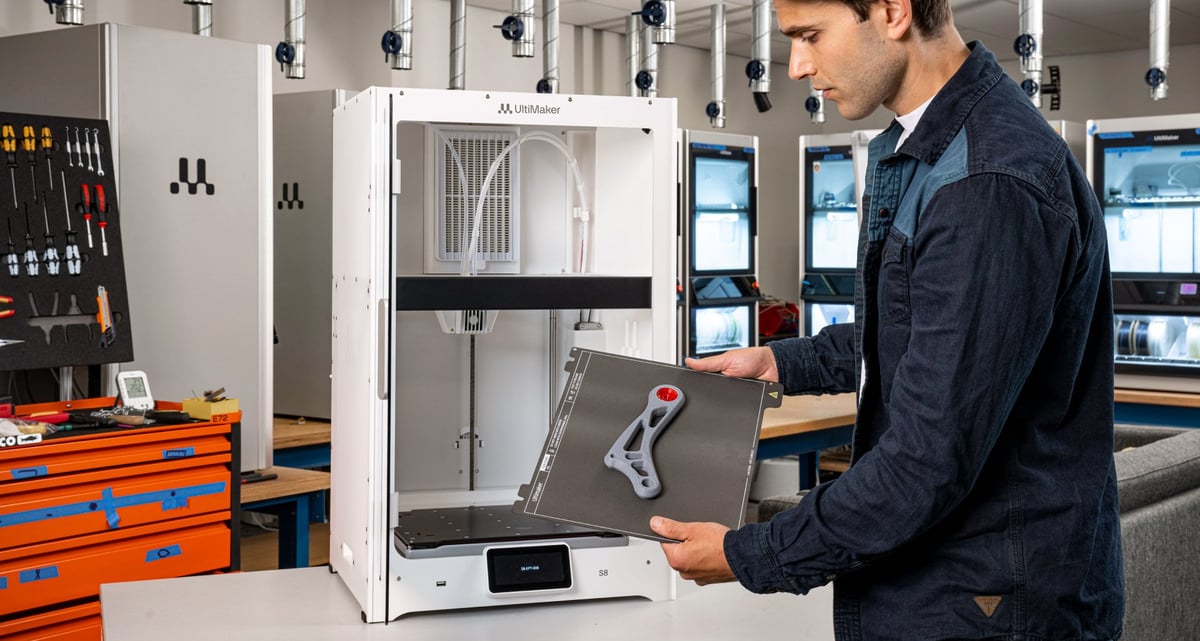
Although UltiMaker has never wanted to talk speed, preferring instead to talk about productivity, now they’re putting their money where their mouth is with a clear print speed of up to 500 mm/s and accelerations up to 50,000 mm/s2. This is equal to the Bambu Lab X1 Carbon in speed and betters it by 30,000 mm/s2 in acceleration.
Clearly, the core driver for UltiMaker was to make a faster printing machine without compromising its reputation for quality. This pursuit began with the “Cheetah motion planner” backed by a “newly developed electronics platform.”
Cheetah is the bit of programming that translates Gcode to printhead movement. One innovation here is that Cheetah is a “jerk-limited” motion planner, which means that you don’t experience any jumps in acceleration that can lead to bulging or blobs at sharp corners among other defects. Basically, the motion planner reacts on the fly to input from the system as its doing the job, rather than following prescribed movement instructions blindly.
“It’s a totally new way of calculating motion paths,” says Marc Uyttenboogaard, a mechanical engineer and the S8 product manager at UltiMaker. “We do have input shaping which is somewhat similar to Klipper, but jerk limited means that we cap the maximum change of acceleration which results in smooth motion with full control over motion path accuracy.”
There’s also a feature called “corner blending”, which is basically “cutting corners” resulting in a much smoother printhead motion,” says Uyttenboogaard. Instead of fully stopping at a corner, the printer moves smoothly through it, keeping higher speeds without skipping steps. There’s not a lack of corners on your models or any visual changes, it all refers to printhead movement.
Cheetah also eliminates issues, such as ringing, blobs, and mechanical stress, which typically occurs at high speeds, UltiMaker says.
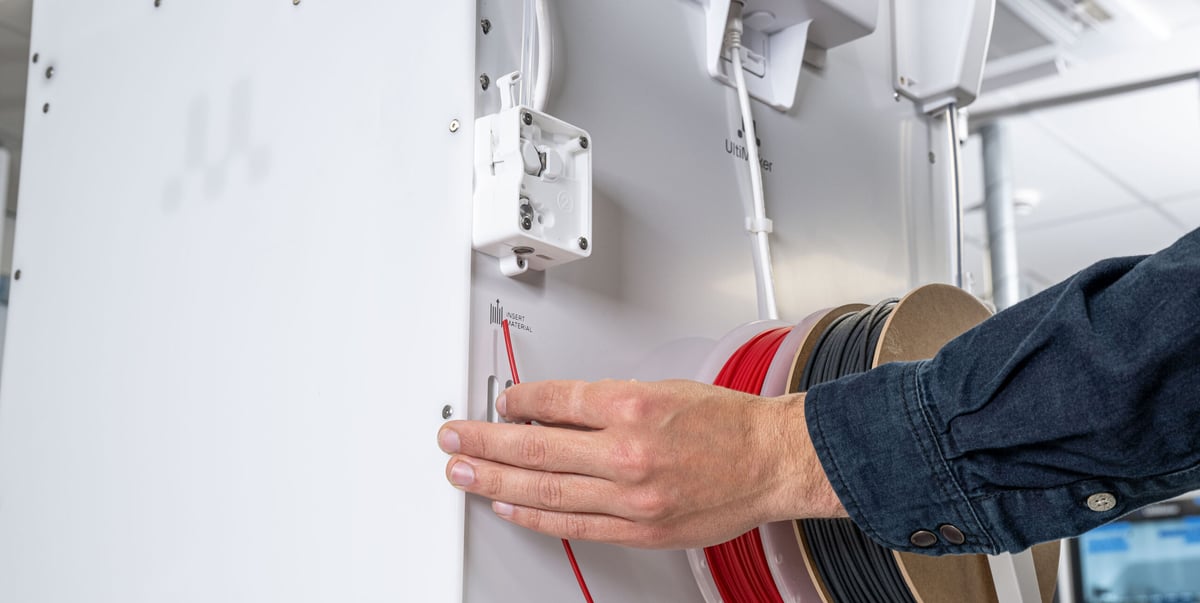
UltiMaker says it has been able to simply offer a faster machine for some time. But speed that compromises quality disguised as “draft mode” wasn’t true to the company’s mission.
While acknowledging that innovation and consolidation at the consumer end of the 3D printer market is rising, which “pushes companies like UltiMaker forward,” according to Uyttenboogaard. “We don’t follow the speed machines of the lower end. We develop our own way of getting there.”
What’s New on the S8
With better control of the printhead’s motion, UltiMaker says it has boosted the machine’s precision to 0.15 mm ± 0.15%. This is the highest accuracy of any UltiMaker 3D printer and it’s attributable to several other new components on the machine.
“In order to benefit from the speed improvements and the dimensional accuracy improvements we made with this motion planner, there were more things that needed to come together,” says Uyttenboogaard. “So we focused on the material flow with the new print cores, material control with the new feeder, and for just plain speed, we added the more powerful electronics platform.”
To deliver more material faster, there is a newly redesigned hardened feeder module (Bowden-style). “We designed it from the ground up,” says Uyttenboogaard, “with hardened gripper wheels similar to the Factor 4 so they can handle any abrasive material. We also improved the tensioning mechanism so it’s more reliable.”
The print head also has UltiMaker’s signature hot-swappable print cores designed for high-flow at 35 mm3/s. The CC+ printcore is for carbon-fiber filled materials.
“If we just go faster with the same architecture, as you would expect, there’s a catch: you compromise on quality or dimensional accuracy,” says Uyttenboogaard. The package of new features increases speed with an improvement on dimensional accuracy and print part quality, he says.
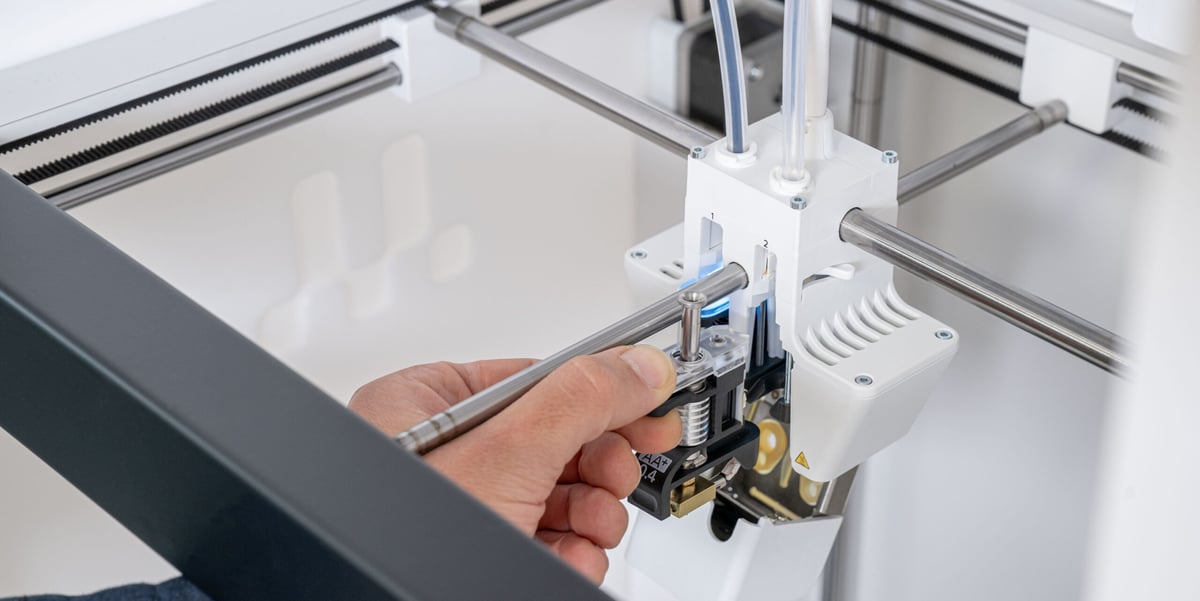
With so much brand new on this machine, we had to ask: Why does it look like the same ubiquitous white box that Ultimaker 3D printers have always sported? The answer, of course, was that UltiMaker isn’t aiming to copy the machine that a lot of companies are trying to copy right now. It has its own strong reputation and tens of thousands of units sold worldwide.
On a more practical level, the S8 needs to have backwards compatibility. For example, the S8 does not come with a material station, but it will be compatible with the existing S7’s six-spool material station. It’s also compatible with all S7 nozzles, but the increased speed is only available with the new AA+ and CC+ nozzles.
The S8, like the Ss before it, has dual-extruders most often used for base material and support material but can also accommodate dual material prints — it can not make 3- or 6-material prints.
There’s a high-definition camera for real-time monitoring, but nothing new in the line of LiDAR sensors or the type of quality assurance sensors that UltiMaker introduced in its Factor 4 ($20,000) last year.
We had to ask: After the S3, S5, and S7, why isn’t this the S9? Uyttenboogaard says it’s because the outside resembles the S7 so the machine is not a “complete overhaul.”
New Carbon-Fiber Material
To complement the launch of the S8, UltiMaker is also debuting a new material that showcases the machine’s abilities. UltiMaker Nylon CF Slide, a nylon 612 CF copolymer offering wear resistance and temperature resistance of up to 180°C, the company says.
The S8 is compatible with 14 UltiMaker branded materials — from PLA and PETG to TPU 95A, PET-CF, PC, and nylon CF — and there are more than 300 other materials you’ll be able to use on the S8 with print profiles provided by the manufacturer downloadable via UltiMaker Marketplace.
Of course, true to tradition, the S8 is compatible with 2.85 mm diameter filament only. Why the resistance to going to a smaller diameter filament, we asked.
Enabling 1.75 mm would make the printer not backwards compatible with the existing materials system, but Uyttenboogaard didn’t completely rule it out. “We’re always looking into the possibility of also supporting 1.75 in the future,” he says, but it’s not in the plans for the S8.
Updated Cloud Software
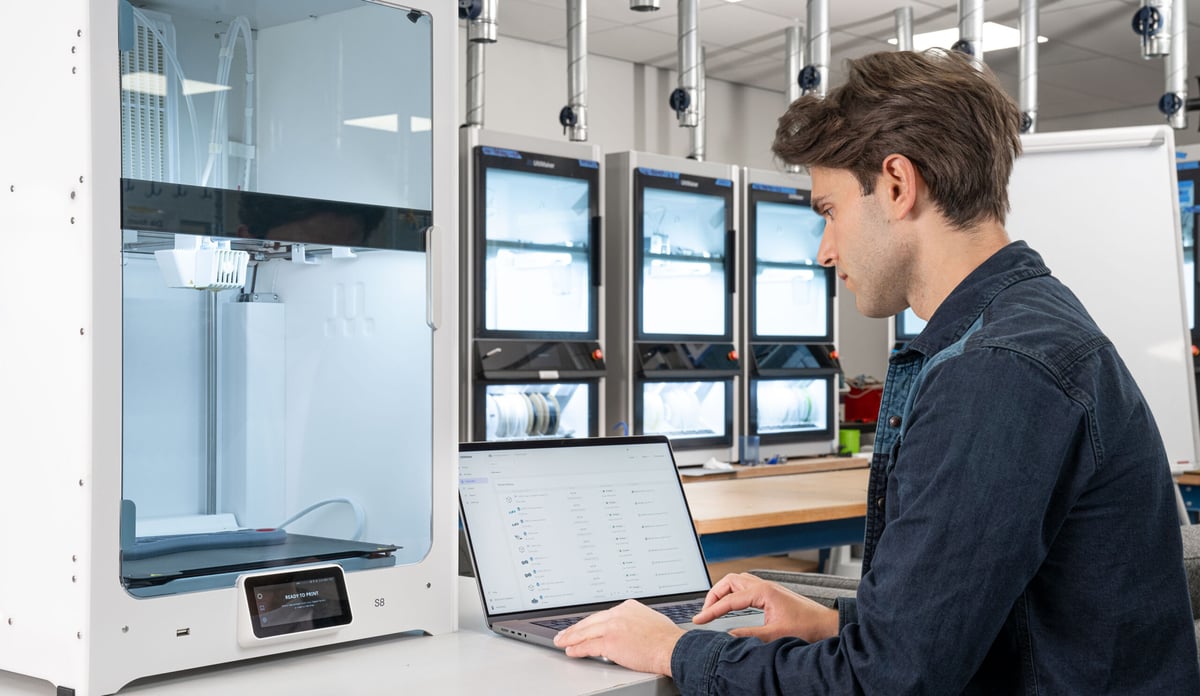
As with most professional FDMs today, the S8 is part of an ecosystem of hardware, materials, and software.
The new Cura Cloud and the existing Digital Factory are the software elements that enable you to slice files and manage print jobs from anywhere.
Digital Factory is the piece that aims to help companies streamline 3D printing workflows and collaboration across teams and locations. There’s a subscription fee for most features a company might find attractive, like pulling machine and project print logs, including print success, failures, and abandoned jobs.
The expansion of Cura from desktop to the cloud is now available for all Digital Factory users. Cura Cloud launched in October for Sketch Sprint users, enabling them to slice, manage, and print all from one platform, but is now open to all.
The printer can be used in isolation from UltiMakers’ cloud-based offering – local wireless or Ethernet connection is all you need to send prints directly from UltiMaker’s slicing software to the printer.
The target audience for this machine is not the home user. At around $9,000, it’s aimed at professionals, such as small manufacturers and machine shops all the way up to automaker prototype shops. In other words, anyone who needs high-strength, high-performance parts with engineering-grade materials.
In the end, for UltiMaker “it’s all about ensuring that the print that the end user has matches the original model, every time,” says Uyttenboogaard.
UltiMaker S8 Tech Specs
- Technology: Fused Deposition Modeling (FDM)
- Architecture: Dual Extruder
- Print volume: 330 x 240 x 300 mm
- Extruders: 2, with swappable print cores
- Nozzle diameters: 0.4. (compatible print cores AA+ 0.4, CC+ 0.4, and BB 0.4 and DD 0.4 sold separately). Also backwards compatible with all S7 nozzles.
- Nozzle temperature: up to 340 °C
- Heated build plate: up to 120 °C
- Max. chamber temp: 50 °C
- Min. layer height: 60 microns
- Print speed: 500 mm/s
- Screen: 4.7-inch full-color touchscreen
- Supported files: STL, OBJ, X3D, 3MF, BMP, GIF, JPG, PNG
- Operating Sound: < 50 dB
- Price: $9,000
You May Also Like:
License: The text of "UltiMaker’s Just-Launched S8 Is Its Fastest Ever" by All3DP Pro is licensed under a Creative Commons Attribution 4.0 International License.
CERTAIN CONTENT THAT APPEARS ON THIS SITE COMES FROM AMAZON. THIS CONTENT IS PROVIDED ‘AS IS’ AND IS SUBJECT TO CHANGE OR REMOVAL AT ANY TIME.
